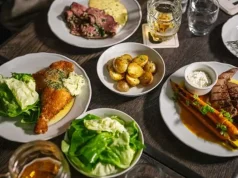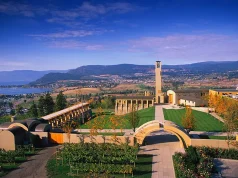
Barcelona’s culinary scene is as colorful and diverse as its famous architectural landmarks. Imagine walking down a bustling street; your senses are immediately engulfed by the sizzling sound of seafood paella being prepared and the rich aroma of fresh bread.
In this vibrant city, every meal is a celebration of flavors that reflect a deep heritage of gastronomy. You’ll find tapas bars where laughter and chatter soar as plates of patatas bravas, and gambas al ajillo get passed around.
Your adventure might lead you to a hidden gem, a family-run eatery, where the secret recipes have been perfected through generations.
Here, you’re not just a customer, but a guest who is about to partake in a culinary tradition unlike any other. Prepare your taste buds, for they are about to embark on an unforgettable journey.
History of Catalan Cuisine
Catalan cuisine has a rich tapestry that weaves together the influences of land and sea. Your journey through this culinary history begins with the Romans, who introduced olives and wine. Fast-forward to medieval times, when the spice trade brought about a fusion of flavors distinguishing Catalan dishes. Arab influence left sweet and savory pairings you can’t resist, like rabbit with prunes.
The mar i muntanya (sea and mountain) philosophy is a testament to the diversity of the region’s produce, combining seafood and poultry in a single delightful dish. For instance, the creative mix of chicken and lobster defines the unique Catalonian flavor profile. The region’s location also means your taste buds get treated to a variety of fresh vegetables, like the irresistible tomàquet (tomatoes) and mongetes (beans).
In the 19th century, the Industrial Revolution, particularly in Barcelona, brought about widespread wealth, further refining Catalan cuisine. The common use of nuts and dried fruits in sauces like romesco or the indispensable picada evolved from this period of culinary innovation. These staples now give a rich texture and deep flavor to many Catalan dishes.
By the 20th century, you witnessed the birth of nouvelle cuisine, pushing the boundaries and creativity of Catalan cooking to a global stage. The famous chef Ferran Adria took center stage, crafting whimsical dishes that surprised the palate. His “spherified olive”, a nod to history, has become a symbol of modern Catalan gastronomy. Whether dining in a historic bodega or a sleek contemporary restaurant, the centuries-old flavors linger in every corner of Barcelona’s culinary scene.
Iconic Foods of Barcelona
When you set foot in Barcelona, your taste buds are in for a real treat with an array of iconic dishes, each boasting its own unique blend of flavors and history.
Tapas
Tapas are not just food; they are a social tradition. Imagine small plates of patatas bravas—potatoes with a fiery aioli, or chorizo laced with paprika. You’re supposed to share, so no guilt if you snatch the last croqueta from the plate!
Paella
Ah, Paella: it’s like Spain on a plate. The key to a sensational paella lies in the sofrito base and the unmistakable saffron. You’ll find seafood paella teeming with shrimp and mussels, but keep an eye out for the mountain variety with rabbit and snails. Don’t get too shellfish with it now!
Catalan Cream
For a sweet finale, sink your spoon into Catalan cream, a lush dessert that’s somewhat of a cousin to the French crème brûlée. The crunchy caramelized topping cracks like thin ice, giving way to a velvety custard. It’s tradition with a sugar-coated twist, yours to enjoy after a hearty meal.
Famous Food Markets
You’re in for a treat as you wander through the bustling aisles of Barcelona’s renowned food markets. Each one boasts a colorful array of fresh produce and a vibrant atmosphere that’s sure to tantalize your senses.
La Boqueria
As you step into La Boqueria, the riot of colors from fresh fruits and vegetables greets you like an artist’s palette. This iconic market, nestled on the Ramblas, is a symphony of sounds from vendors selling everything from jamon to exotic spices. Don’t miss out on the juice bars for a refreshing sip—think of it as a fruity pitstop.
Sant Antoni
When you stroll into the Sant Antoni market, it feels like you’ve discovered a secret foodie paradise. This modernista structure houses stalls that offer a bounty of the sea and land, and yes, that includes your soon-to-be favorite Catalan cheeses. On Sundays, locals flock here, not for food, but for the outdoor book market—a little-known twist.
Santa Caterina
The undulating roof of Santa Caterina often captures gazes before the mouthwatering treats inside pull them away. It’s smaller and less touristy than La Boqueria, giving you a more authentic Barcelona market experience. Come for the ham and cheeses; stay for the cozy bars that sprinkle the perimeter, perfect for a tapas break.
Typical Barcelona Dishes
Barcelona’s cuisine is a treasure trove of rich flavors and unique dishes that speak of its coastal and cultural heritage. You won’t want to miss out on these tasty delights.
Escudella i Carn d’Olla
Imagine a stew that brings the whole farmyard into your bowl. Escudella i Carn d’Olla is that dish; it’s the Catalonian twist on comfort food. A hearty soup typically savored during the winter months, it features a medley of meats—everything from beef to chicken and sometimes even a piece of chorizo for an extra zing. All this is married with a bounty of vegetables like potatoes and carrots. Your spoon dives in and comes out with a bite that assures you, you’re tasting the heart of Catalonia.
Botifarra amb Mongetes
Enter the realm of simple yet flavor-packed foods with Botifarra amb Mongetes. Think of a juicy, herbed pork sausage—botifarra—that meets the humble white bean—mongetes—in a dance of classic Catalan cuisine. Often, a sprinkle of parsley and a drizzle of olive oil join the party to dress up the dish. It’s a perfect pairing that balances rich meaty flavors with the soft, earthy taste of beans.
Fideuà
The lesser-known cousin of paella, Fideuà, might just become your favorite seafood indulgence. Swapping out rice for short noodles, this dish captures the essence of the Mediterranean Sea.
Squid, shrimp, and fish cut through the carbs, telling a story of Barcelona’s love affair with the ocean’s bounty. Each bite brings a wave of aromatic saffron and the kind of culinary satisfaction that’s best followed by a leisurely siesta.
Explore Barcelona’s Tasty Secrets with BCN.travel
Ready for a yummy trip? BCN.travel is your go-to guide in Barcelona. They know all the best food spots and stories. Learn to cook local dishes, wander through famous markets like La Boqueria, and find hidden places to eat. It’s not just about food; they help with cozy places to stay and cool history tours too. With BCN.travel, you’re not just seeing Barcelona; you’re living its tasty adventures.
Barcelona’s Dining Scene
From avant-garde tasting menus to heartwarming traditional dishes, Barcelona’s dining scene will take your taste buds on an unforgettable journey.
Michelin-starred Restaurants
In the constellation of Michelin-starred restaurants in Barcelona, you’re spoilt for choice. Tickets offer a playful twist on tapas that might just make you giggle with delight. Over at Lasarte, expect nothing less than culinary wizardry on a plate, where every bite is a masterpiece of flavors.
Traditional Catalan Restaurants
Savor the heart of Catalonia in its traditional restaurants.
Can Culleretes, the city’s oldest eatery, serves up more than just food; it dishes out history with every spoonful. 7 Portes brings you the iconic dish ‘paella’ and a side of soul-warming ‘suquet de peix’, both wrapped in an ambiance that feels like a warm hug.
Seafood Specialties
Barcelona and seafood are a match made in heaven. La Paradeta offers a seafood encounter where you pick your catch, and they cook it to perfection—a truly interactive dining experience. Don’t miss the bombardment of flavors at Mariscco, where the freshest creatures of the sea turn into dishes that are sure to make a splash.
Food Tours and Culinary Experiences
Exploring Barcelona through its flavors is a must-do for any food enthusiast. Your taste buds will thank you for taking them on a gastronomic tour, where tapas and paella aren’t just dishes but gateways to Catalan culture. Ideal for gourmands, food tours cover a range of eateries from bustling La Boqueria Market to quaint neighborhood bars.
- Local Markets and Bodegas Tour:
- Visit the famous La Boqueria and lesser-known markets.
- Sample artisanal cheeses and Iberian ham.
- Enjoy a sip of cava at a hidden bodega.
Be prepared to walk, as some of the best experiences are tucked in narrow alleyways. The “Sweet Tooth’s Stroll” is perfect if you’re keen on a sugary affair, featuring artisan chocolates and churros with thick, hot chocolate.
- Gourmet Tapas Adventure:
- Indulge in a variety of tapas.
- Learn about the local ingredients and preparation methods.
- Pair each bite with the ideal Catalan wine.
Don’t shy away from asking questions; your guide is a fountain of knowledge waiting to be tapped. Venture off the beaten path with a Farm-to-Table Experience, where you’re whisked away to a countryside farm to relish in organic produce and traditional methods.
- Cooking Class and Market Visit:
- Participate in an interactive cooking class.
- Prepare your own seafood paella under expert guidance.
- Enjoy your creations with new friends.
By the end of your journey, you’ll weave through Barcelona’s culinary maze like a local, garnished with insider knowledge and a full belly.
Regional Wines and Cavas
If you’re keen to sip your way through Barcelona, the regional wines and cavas are not to be missed. Your taste buds are in for a treat with the world-renowned Penedès and Priorat offerings.
Penedès Region
Located a stone’s throw away from Barcelona, the Penedès region is famous for producing a wide range of wine styles, but it’s the cava that might just make you pop with excitement. Known for its traditional sparkling cavas, Penedès vineyards employ native grapes like Xarel·lo, Macabeo, and Parellada, which contribute to the distinctive crisp and refreshing flavor profiles.
Here’s a quick sip of information:
- Xarel·lo: provides body and citrus notes
- Macabeo: adds freshness and aromatic delicacy
- Parellada: offers acidity and finesse
Priorat Wines
Pouring into your glass from the steep slopes of Catalonia, the wines of Priorat have a gravitas that commands attention. The local llicorella soil, densely packed with slate, blesses the vines with a unique mineral quality that you can taste in the wine. The bold reds from this area, primarily made from Garnacha and Cariñena grapes, are robust with a strong personality:
- Garnacha: yields jammy and spicy notes
- Cariñena: contributes deep color and tannic structure
When you swirl a glass of Priorat, it’s like receiving a firm handshake from the land itself.
Local Dining Etiquette and Customs
When you sit down to dine in Barcelona, you’ll notice the Spanish penchant for leisurely meals. Meals are more than just eating; they’re a time for socializing.
Take your time with the menú del día, a multi-course lunch offering that is both a bargain and a cultural experience. Expect to linger over your meal, as rushing is a faux pas in this culinary context.
Remember to say “Bon profit” before starting your meal, similar to the French “Bon appétit,” to wish your companions an enjoyable meal.
This local phrase will earn you nods of appreciation from those around you.
When the bill arrives, don’t split it down to the last cent! Spaniards often either split the bill evenly or take turns paying the entire amount on different occasions. Trying to pay only your exact share might cause a change in the table’s mood – and not for the better.
In terms of tipping, it’s simple: Tipping is not as obligatory in Barcelona as it may be elsewhere. If you feel the service was exceptional, leaving a 5-10% tip will be a pleasant surprise for your server. If you receive a toothpick with your tapas, here’s a fun twist: leave it on the plate once you’re done. It’s a way for servers to count how many you’ve had like a flavorful abacus that you can eat from.
Lastly, don’t be afraid to use your hands. Certain foods, like pan con tomate (bread with tomato) and jamón (ham), are finger-friendly, and it’s perfectly acceptable to indulge as the locals do.
Seasonal and Festive Foods
In Barcelona, your taste buds get to celebrate the changing seasons with an array of festive foods. Spring welcomes you with calçots—sweet, grilled spring onions dipped in romesco sauce. Come summer, the sun ripens the fruit to perfection, and you’ll find the vibrant La Mercè festival dishing out coca de Sant Joan, a sweet flatbread topped with candied fruit.
Autumn is not to be left behind; it’s the time for panellets. These are little marzipan balls rolled in pine nuts, paired best with a glass of moscatell on All Saints Day. Winter calls for turron, a nougat made from almonds and honey, a treat that finds its way into every home during Christmas.
When the streets light up for Fiesta Mayor de Gracia, savor some fideuà, a noodle dish cooked with seafood that often gives the famous paella a run for its money. And just for a dash of humor, try not to wear white when attacking a calçot—you might end up with a Rorschach test on your shirt!
- Spring: Calçots with romesco sauce
- Summer: Coca de Sant Joan
- Autumn: Panellets and moscatell
- Winter: Turron
Each season in Barcelona is an invitation to indulge in these culinary delights that are as much a part of the festivities as the events themselves.
Author
Christian Petzold is a successful tourism entrepreneur, experiential traveller and round-the-world backpacker. He holds an academic degree in tourism management. His touristic expertise has been covered in radio, newspaper and television.





